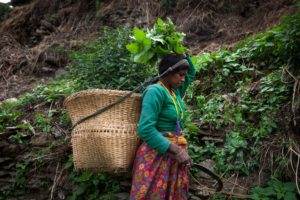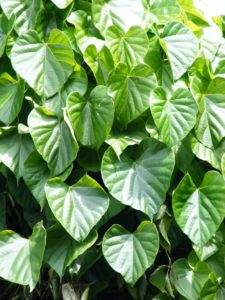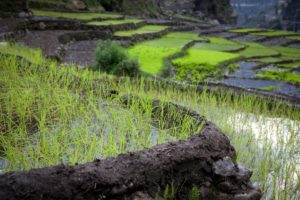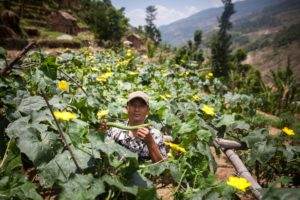Nepal’s mountains are a rich source of healing plants that have benefited people’s health and livelihoods for generations. But climate change is threatening their survival. Health benefits are being lost, livelihoods are at risk, and ancient knowledge is disappearing.

In Nepal’s Bajura district, the mountains are a source of both food and medicine for local communities.
The benefits of medicinal plants

The leaves of the Gurjo plant, used for centuries in Nepal to boost immunity.
There are around 7,000 plant species in Nepal, around 100 of which are used in medicine. Interest in Nepal’s medicinal plants isn’t new. Many people in Nepal can’t afford modern healthcare and rely on these ancient remedies to keep their families healthy.
Further afield, the plants have been popular for centuries in India for their use in ayurvedic medicine, and in China for traditional healing. chiraito (Swertia chirayita), native to the foothills of Nepal, has antibiotic properties and is used to treat dozens of ailments.
Another native herb, famed for its ability to increase immunity, is gurjo (Tinospora cordifolia). Used for centuries by ayurvedic practitioners to boost the immune system in patients with chronic illnesses, it’s found new fame recently as people look for natural ways to reduce their chance of contracting coronavirus.
The plants are also used in many Western medicines. For example, Himalayan yew (Taxus baccata) is an active ingredient in Taxol, which is used to treat cancer.
An ancient source of income
It’s not just people’s health that benefits from the trade in medicinal plants. For farmers in Nepal’s isolated regions, many of whom live in extreme poverty, it can be a valuable and sustainable income stream.
Many of the farmers we work with in Nepal gather and sell medicinal plants alongside growing vegetable and cereal crops. But just as climate change is making traditional farming more difficult, it’s also threatening the survival of healing plants that have sustained health and livelihoods in the region for generations.
The impact of climate change
Studies by The International Centre for Integrated Mountain Development and others suggest that mountain ecosystems are particularly impacted by climate change. Advancing tree lines and extinctions of mountain plant species have become increasingly apparent and documented by researchers worldwide in recent years. We’ve heard first-hand from people living in Nepal’s foothills that many medicinal plant varieties are becoming increasingly scarce.
The Intergovernmental Panel on Climate Change predict that the Himalayas are likely to experience some of the most drastic climate changes in the world outside of polar regions, with temperature increases of 5-6°C and precipitation increases of 2030%. It’s more bad news for the delicate plants that grow solely in these mountains.
Nowhere left to grow

Climate change is causing changes to the landscape that are impacting both farmers and the environment.
Some cold-adapted plant species in mountain environments have begun to gradually climb higher up the summits as temperatures rise. In some cases, these plants migrate upward until there are no higher areas to inhabit, at which point they may be faced with extinction. Additionally, this upward migration can lead to increased competition for space and resources between plant species. The warmer air is also melting glaciers, a process which is further altering the delicate mountain ecosystem.
Extreme weather events present another challenge. Floods and droughts, made worse and more frequent by climate change, destroy fragile plants. Seeds are killed or washed away, making it impossible for a species to re-establish itself.
Why cultivation isn’t a solution
An obvious solution is to cultivate medicinal plants, but this is easier said than done, as many of them are extremely difficult to grow. The Snow Lotus (Saussurea laniceps), endemic to Nepal and used to treat high blood pressure, is an example. An expert describes the conditions it needs to thrive as “unique and somewhat unfathomable”.
Even when medicinal plants can be successfully cultivated, doing so is expensive and time-consuming and plants can take years to mature. Cultivation certainly isn’t a viable option for smallholder farmers.
Adapting to climate change

In Bajura, Tek and his family are using planet-friendly farming methods to increase his farm’s productivity.
The threat to Nepal’s medicinal plants is yet another example of the people least responsible for climate change being most impacted by it. Without global action, this natural resource that has benefited people’s health and livelihoods for generations is at risk of being lost forever.
It doesn’t have to be this way. With ingenuity, farmers in Nepal can adapt to the challenges created by the climate crisis, using techniques that improve their livelihoods while protecting their natural environment.
We know it’s possible because we’re already working with farmers in Nepal to make it happen. Hardy seed varieties are making crops more resilient to new weather patterns. Renewable solar-power is watering fields during dry periods – without depleting natural resources. And training in planet-friendly farming techniques means bigger harvests for farmers without damage to the environment.
With your support, more farmers like Tek can adapt to climate change and thrive – using traditional, sustainable methods that don’t cost the earth.